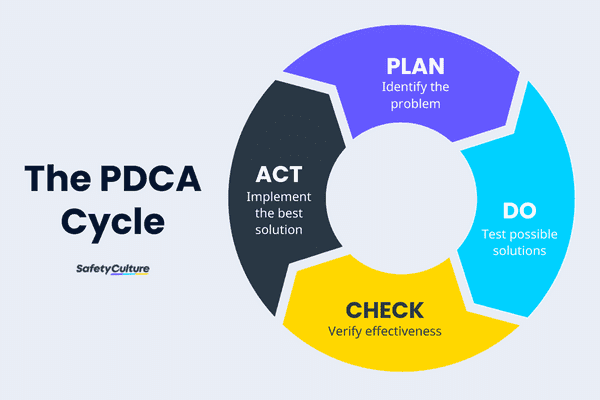What is the PDCA Cycle?
The PDCA cycle is a process-improving method that involves a continuous loop of planning, doing, checking, and acting. Each stage of the PDCA, meaning the Plan-Do-Check-Act, cycle contributes to the goal of identifying which business processes work and which of them need further improvement. This methodical approach is also utilized to avoid recurring mistakes and errors in operations.
The PDCA cycle was first introduced by Dr. Walter Andrew Shewhart in 1939. It was then further developed by Dr. William Edwards Deming in the 1950s to help organizations achieve progressive improvements and monitor the quality of changes in their processes. This cycle—also dubbed the Deming Wheel—has since been a widely used strategy tool for businesses and organizations across all industries.
This process-improvement model is best characterized as a continuous loop where the cycle is restarted if one of the elements in the implemented change is found to be ineffective and repeated over and over until the most desired outcome is reached.
Stages of PDCA
The PDCA process consists of four stages (also known as the PDCA steps): Plan, Do, Check, and Act. It aims to solve problems and methodically implement change. So, what is the role of each stage in the whole cycle?

The PDCA Cycle
Plan
First, note that this stage is the backbone of the whole cycle so you have to be as comprehensive and as detailed as possible.
Specifically describe the problem to be solved and state why it is important to be addressed. Discuss objectives and create Smart, Measurable, Achievable, Relevant, and Time-bound (SMART) goals that your team members and relevant stakeholders agree upon. Aside from that, the end of this stage should materialize in a comprehensive plan answering information-building questions such as:
- What is the cause of the problem?
- What are the current standards and procedures regarding the specific process?
- What resources are needed to implement the proposed changes?
- What are the potential hindrances in achieving the project goals?
- What measures should be taken to address the problem?
- What is the ideal schedule/deadline to complete the implementation?
- What are the criteria for the project to be considered a success?
Essentially, all elements factoring in the project should be stated and planned at this stage before moving on to the next.
Do
Since you’ve identified potential solutions to the problem in the first stage—”Do” is the part where you’ll execute them. Apply the changes but only on a small scale or controlled environment such as specific department, project, or with just a particular demographic.
This is to ensure that if ever the changes were ineffective or if they resulted in a negative impact to your process or business, there won’t be much damage to deal with and minimal resources were used.
After the initial testing, gather all the relevant data to show if the recognized potential solutions worked or not.
Check
This is the analysis stage—with your data from the previous stage, evaluate the effectiveness of the implemented solutions. Compare them to the success criteria included in the planning stage.
Assess if the result is already satisfactory and the solutions are already working according to the objective, or if they need further improvements to achieve the overall goal.
If further adjustments are needed, go back to the first stage—Plan—and try other alternatives that you think could work to solve the problem. If it’s considered a success, however, you can now proceed to the next stage, Act.
Act
Once you’ve recognized the effectiveness of the solutions, “Act” is the stage where you’ll fully implement them as part of your business process.
To continuously achieve greater and more standardized results, it will be helpful to also address the following questions:
- What resources are needed to successfully implement the solutions?
- Would training be necessary in implementing the developed solutions?
- What other opportunities can be maximized?
- Is there an opportunity to measure the results more accurately?
The PDCA method is a simple yet powerful tool that gives you the option to repeat the cycle if you think that the solutions can still be improved. In some cases, you may need to go through the four stages again if there are factors or changes that could affect the way the implemented solutions work.
Importance of Plan Do Check Act Cycle
The PDCA cycle is one of the widely used methods of monitoring quality management systems and is applicable to international standards such as ISO 22301, ISO 9001, ISO 45001, and ISO 27001. It allows organizations to gather relevant information and use it as a well-grounded basis before deciding whether to proceed with the plan or improve it further. Through this data-driven method, organizations can work to continuously improve their processes, products, and services.
The continuous approach of PDCA also offers time-saving opportunities by catching mistakes early on in the project. This helps strengthen the efficiency of the cycle and eliminates ineffective elements until an ideal solution is identified.
Furthermore, the PDCA cycle is versatile—it can be used across all industries, by big businesses, and even by specific teams or departments within a company.
Explore our Free PDCA Templates
See how digital checklists simplify business processes with just a tap.
View nowPDCA Example
Below is an example of how to use the PDCA cycle:
Scenario: An auto supply company is experiencing customer service issues caused byproduct shipping delays. The supply chain manager chose the PDCA method to identify solutions and avoid the occurrence of the same setback in the future.
| Plan | Identify the problem:
Three customers experienced a two-week delay before receiving the products they ordered from us. Two of them ordered a box of side-view mirrors, while the other one ordered five new batteries. The objective of this cycle is to understand what caused the delay and to avoid it from happening again and prevent our customers from having a bad experience. |
| Observe:
Because of this, we received a complaint from the customers saying the delay also caused a setback in their operations. We gave the customers a huge discount to compensate for what happened. No bad reviews (so far). |
|
| Analyze:
We did an investigation and discovered that the cause of the hold up was an unexpected delay from our supplier for the specified vehicle parts. Our supplier’s facility is situated in Texas and was recently hit with a strong cyclone, which also interfered with their production. |
|
| Action Plan:
The main action plan for this is to find an alternative supplier that can provide us with the mentioned products in case something like this happens again or in case of emergencies.
|
|
| Do | Execute:
We’ve sent out a Request for Proposal (RFP) to possible alternative suppliers and filtered out the options based on our set requirements. |
| Check | Verify:
|
| Act | Standardize:
Now that we were able to solve this problem using this solution, let’s fully implement it across our other products. Find alternatives and take into consideration the factors specified in this cycle. |
Based on the use of the PDCA cycle done to solve the existing problem, the solution identified and implemented was effective. The auto supply company now has a fallback in case a delay in the production is observed. They would also be able to prevent instances like this from affecting their own customers, which is the main goal of the plan.
Achieve operational excellence
Cultivate a culture of excellence with our digital solutions that enhance efficiency, agility, and continuous improvement across all operations.
Explore nowMonitor PDCA Cycle with SafetyCulture (formerly iAuditor)
The PDCA cycle involves a lot of information, changes, and updates per use. It should be streamlined for easy tracking and to serve its documentation purpose through storing all of the relevant data in one accessible space.
SafetyCulture is a digital tool that industry leaders can use in monitoring PDCA cycles across various industries. With SafetyCulture, you can track your progress regularly and also do the following:
- Create your own problem-solving cycle using pre-existing PDCA Templates, or customize your own template according to your business and industry needs.
- Store all your information in one safe space and visually monitor trends in every cycle using the Analytics dashboard.
- Schedule recurring cycle checks and automatically get notified.
- Improve your processes further by creating actions or reporting recognized issues.
- Generate PDCA reports and share them with your team via PDF or emails.
FAQs about PDCA
The primary difference between the two lies in their Check and Study stages. While PDCA is used to generally assess the effectiveness of a change in a process, PDSA offers a more thorough approach, utilizing analytical methods to validate the impact of the change. PDCA is commonly used by businesses and organizations, while PDSA is maximized in healthcare settings.
The PDCA cycle is best used when there is a need to implement and continuously improve a process, product, or service. It can also be beneficial for organizations simply because there’s a newly-introduced change in daily processes. PDCA is particularly effective in situations where structured problem-solving and iterative refinement are crucial for achieving desired outcomes.
While PDCA is not specific to either Lean or Six Sigma, it is a key tool used in both methodologies to drive quality enhancement and process optimization.




